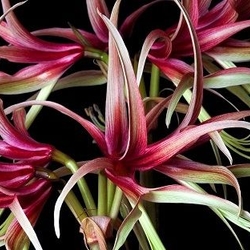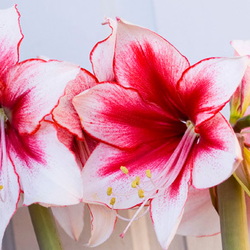(Editor's Note: This article was originally published on January 8, 2008. Your comments are welcome, but please be aware that authors of previously published articles may not be able to promptly respond to new questions or comments.)
Each year, I purchase several new amaryllis bulbs. Growing them on from year to year is far more rewarding to me than composting them each January and buying them anew the following November or December. I'm especially happy to have a more expensive, rare variety or a particular favorite do well and bloom again for me the following year.
After the bloom has faded, the flower stalk can be cut off near the top of the bulb. Be careful of the leaves as you make the cut, and don't worry about the juicy sap that may run out of the cut stalk.
Treat your amaryllis as you would any houseplant, with regular water and fertilizer. Amaryllis plants like sun, the brighter the better, especially in winter. If you tuck it in a dim corner, it may survive, but more sun means better growth and better bloom next year. 
When late spring temperatures are above 50oF at night, you can move your amaryllis outside. Many people simply move pot and all into a sunny spot. That works as long as you remember that it likes to be watered regularly.
I find it's easier to take care of my amaryllis plants if I plant them out into the garden. They get plenty of sun in the bed by my deck. To simplify watering, I run a soaker hose between the bulbs. If you plant them in the ground, follow the same guidelines as for planting in pots, leaving the upper 1/3 of the bulb exposed above the soil line.
The more water, sun and food your amaryllis plants get during the spring and summer, the more leaves they will grow. The more leaves they grow, the more photosynthesis occurs to feed the bulb, and the larger the bulb will grow. The larger the bulb grows, the more flower stalks it will put up the next time it blooms. I've heard that for every 3 to 5 leaves an amaryllis plant grows, the bulb will put up one additional flower stalk the following year.
Amaryllis plants are tender and must be lifted in fall, before a hard freeze kills the bulb. How early you lift them depends on whether you are trying to time their bloom. For holiday flowers, you'll be digging bulbs in mid-August. I often pot up new bulbs in time for holiday blooms and enjoy my older amaryllises later in the winter, simply because I don't think of lifting them at the height of summer.
Here's a way to calculate the dates involved. Mark the approximate “bloom by” date you want on the calendar, remembering that you might have to be flexible. Count back the approximately eight weeks it will take for a potted bulb to start blooming, and mark the date you should pot up the bulb. Count back an additional eight weeks of dormant resting time, and mark a date to dig the bulb (or remove it from its pot). 
When you dig up the bulb, brush or wash most of the dirt off the roots, and let them dry. Cut the foliage off about an inch above the top of the bulb. Put the bulb in a cool, dark place with good air circulation until it's time to pot it up. Often, the bulb will start sprouting the tip of a flower stalk to tell you it's ready to go. For potting up the bulb, follow the directions in Amaryllis 101: Planting Amarllis Bulbs for Winter Bloom.
If you're content to let your plant bloom when it will, there's no need to put the amaryllis bulb through an official dormant period. You can let the foliage remain on the bulb when you dig it up, or you can simply bring a potted plant back inside in fall. By doing so, you may encourage your amaryllis to bloom more than once each year! 
Some of my older bulbs have produced offsets, which can be potted up separately or grown on with the mother bulb until they reach blooming size. I've also grown a few amaryllis plants from seed – an exercise in patience, as they can take 3 to 5 years to bloom for the first time. Over the years, my collection of amaryllises has gradually increased. This year, I dug 28 bulbs out of my “tropicals” bed by the deck!
I don't make any particular effort to put mine through a dormant period. I find that some of the leaves get damaged or lost, while the foliage on other plants stays healthy and full. So some of the amaryllis bulbs that I pot up end up going dormant to some extent, and others don't. Sometimes I pot them up right away, other times the bulbs may sit around for several weeks after I dig them up.
All the potted bulbs go on a sunny shelf in my basement. Every so often, a couple of them will start putting up bloom stalks, and I'll bring them upstairs to enjoy their flowers. With so many amaryllis bulbs doing their thing at different times, I know I'll have spectacular blooms to enjoy all winter long.
For additional information, see the National Arboretum's directions for How to Make Your Amaryllis Bloom Again. Dave's Garden has an entire discussion forum devoted to Amaryllis and Hippeastrums, and you'll find photos and posts there from beginners and experts alike.
Photos by Jill M. Nicolaus. Cultivars: 'Pink Impression', 'Blossom Peacock', 'Supreme'

















